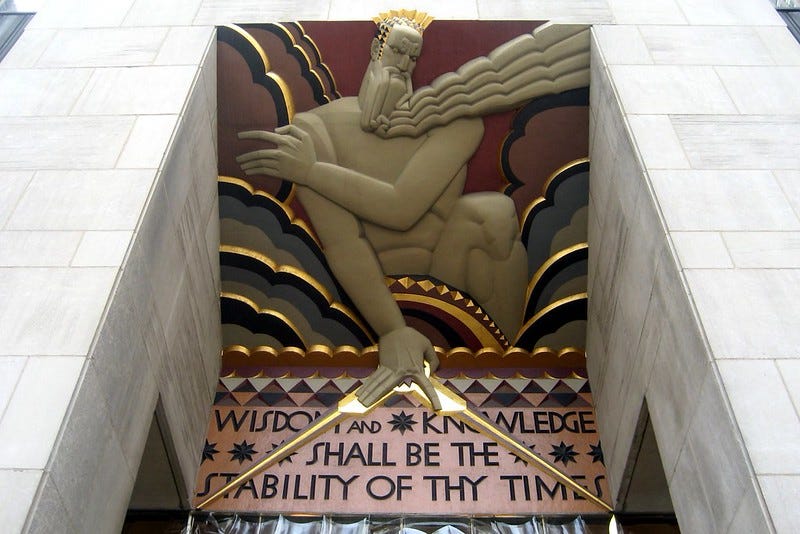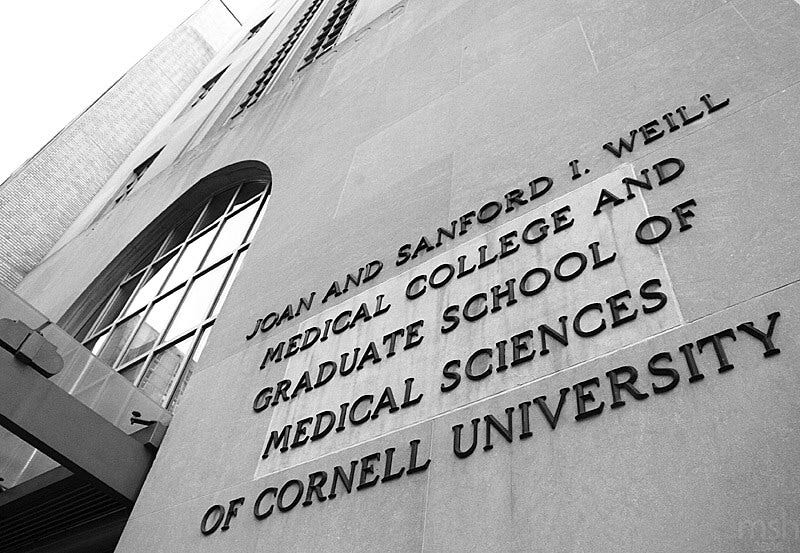Part 2, Cultural Hegemony in the 21st Century
Institutional Control, Credentialism, Deplatforming, Language Control
This is the second in a series of articles. Part 1 defined the concepts of cultural hegemony, common sense, and submission, and it provided examples of how the concepts can be observed empirically.
As we briefly mentioned in the previous article, cultural hegemony arises from wealth, social prestige, and institutional control.

Activist Groups, Mass Media, and Education
The main institutions that the 21st-century cultural hegemony controls are activist groups, mass media, and educational institutions.1 These types of organizations are heavily dependent on wealthy donors or owners.
Billionaire philanthropists typically finance prominent activist groups. John D. Rockefeller III—one of the heirs to the Rockefeller oil fortune—funded the movement to legalize abortion-on-demand by way of the Population Council and the Association for the Study of Abortion.
Mass media corporations are often privately owned by wealthy capitalists: for example, Arthur Ochs Sulzberger Jr. personally owns and chairs The New York Times, while Jeff Bezos, one of the wealthiest individuals in the world, personally owns The Washington Post.
Educational institutions, particularly elite ones, are responsive to the direction of their largest donors. This is not hidden, since large enough donations to academia come with the status symbol of naming rights.
For instance, the Weill Cornell Medical College is named after Citigroup chairman Sanford Weill and his wife, who donated over $600 million to Cornell and directly shaped curriculum reforms, research priorities, and hospital expansions.

On the other coast, the Knight-Hennessy Scholars program at Stanford University—created with a $400 million gift from Nike co-founder Phil Knight—established a new admissions track and campus facilities explicitly tailored to his vision of cultivating “global leaders.”
Credentialism and the Professional-Managerial Class (PMC)
While wealthy capitalists have their names emblazoned on these institutions, the institutions themselves are staffed by members of the professional-managerial class (PMC).2
The PMC comprises individuals who earn a living not through physical labor, but through abstract, symbolic skills. A rough way to define the PMC is to include all jobs for which a four-year college degree is required for entry.
This is a broad definition. The CEO of a billion-dollar corporation or the president of an Ivy League university wields far more social capital than an accountant or a computer programmer. Still, they are all part of the PMC.3
The PMC is usually contrasted with two other classes.
The capitalist class comprises less than 1% of the United States population and includes individuals who own companies or have inherited wealth from such ownership, thereby becoming independently wealthy.
The working class comprises individuals who earn a living through physical labor. The converse of the above definition of the PMC is that the working class includes all jobs that do not require a four-year college degree as a prerequisite.
One of the defining traits of our society is the explosive growth of the PMC. According to the Education Data Initiative, only 2.7% of adults over 25 years of age even had a college degree in 1910. According to the Bureau of Labor Statistics' estimates for 2021-22, 41.6% of workers aged 25 or older had a bachelor’s, master’s, doctoral, or professional degree.
Thus, the PMC has experienced unprecedented expansion relative to the population as a whole, though it remains a minority. On the other hand, the working class has shrunk proportionally, but remains the majority of the country.
While one might argue that modern professions genuinely require more education, anyone with a college degree knows how little their coursework prepared them for their actual job.
The main driver of PMC growth is credentialism, the gatekeeping of roles in society by requiring a college degree.
Americans have strong incentives to attain college degrees. According to the U.S. Bureau of Labor Statistics’ The Economics Daily of April 29, 2025, high school graduates with no college education had median weekly earnings of $953. Those holding at least a bachelor’s degree had median weekly earnings of $1,754, almost twice as much.
In addition to the economic incentive, nearly all positions of leadership or cultural influence in modern society require a college degree to occupy them. This was not always the case. For instance, journalism was once viewed as a “blue-collar” job for which a college degree was not necessary; however, it is now a heavily credentialed profession.
Representative data are only available from 1971 on, when the American Journalist surveys began. However, even as late as 1971, only 58.2% of American journalists had college degrees. Furthermore, there was an age cohort effect: only 45.5% of journalists over 55 years old had college degrees, compared with 64% of journalists aged 25-35 years old. (Weaver et al., 2009, pp. 36-38)
Now, according to the most recent survey from 2022, a whopping 96.4% of American journalists have college degrees.
The rise of credentialism is closely tied to that of cultural hegemony. The culture of the university—particularly elite universities—and the actual culture promoted by today’s hegemony are virtually the same.
Thus, incentivizing people to attend university ensures that more people—including most affluent and influential members of society—will be exposed to hegemonic culture for four years or more. During these years, young PMC aspirants learn to emulate certain viewpoints and signal particular virtues to advance their status and careers.
Historically, wealthy members of the capitalist class have financed cultural hegemony. This is still often the case, but due to the rise of managerialism, wealth can sometimes separate from capitalists, allowing members of the PMC to direct a hegemony.
While John D. Rockefeller III personally directed the funds he inherited toward population control and abortion advocacy, Henry Ford II was infamously so distraught over the Ford Foundation’s use of his father’s money that he disavowed himself from the organization. In the case of the Ford Foundation, high-status members of the PMC were the hegemons instead of wealthy capitalists.
Deplatforming
Credentialism, in addition to inculcating conformity with cultural hegemony, also provides the hegemony with a robust selection mechanism to control what opinions the public encounters.
Processing people through the university system—where taking a “wrong” viewpoint becomes conspicuous—allows selection processes to admit, hire, and promote only those who sufficiently conform to the hegemony’s orthodoxies.
An aspiring journalist who deviates from the hegemonic viewpoint on race, gender, immigration, abortion, foreign policy, firearms policy, etc., will be passed over for “mainstream” opportunities and left to try to find work in alternative or “right-wing” media.
Aspiring scholars who apply to graduate school can be weeded out by their political viewpoints through perusal of their mandatory DEI statements. This requirement makes formal what was done informally in past generations.
A similar process applies to professional organizations in law, medicine, public health, and social work. Thus, official-sounding pronouncements from professional organizations tout hegemonic viewpoints.
The result is that viewpoints that differ from cultural hegemony are deplatformed from “mainstream” society.
Much has been made of very public “cancellations,” in which a celebrity says something opposed by hegemonic forces and loses a job and/or a place in public life. These cancellations are relatively rare.4
However, what is more profound than cancel culture is the daily advancement of certain people in society over others, again and again, until dissenting voices are deplatformed.
Language Control
Today’s cultural hegemony is very concerned with controlling language. This is partly an extension of the professional instincts of the hegemony's foot soldiers. Members of the PMC often have vocations concerned with symbolic capital—to borrow a phrase from
—so it follows they would be concerned about what symbols are allowed and not allowed.However, controlling language is also a deliberate way to control how people think. This tactic is used prolifically by today’s cultural hegemony.
For instance, the phrase “affirmative action” was originally coined in President John F. Kennedy’s Executive Order 10925, Part III. “Obligations of Government Contractors and Subcontractors”:
The contractor will not discriminate against any employee or applicant for employment because of race, creed, color, or national origin. The contractor will take affirmative action to ensure that applicants are employed, and that employees are treated during employment, without regard to their race, creed, color, or national origin.
Thus, it originally meant affirming that there was no racial discrimination occurring. Over the years, hegemonic forces have reinterpreted the phrase to mean the exact opposite: the presence of race-based discrimination (favoring certain “underrepresented” groups). This inversion in meaning can confuse public opinion.
For instance, a Pew Research Center poll of Asian Americans (2023) found that 53% of respondents who have heard of affirmative action said it is a good thing. The same poll also found that only 21% of respondents said that race or ethnicity should be considered in college admissions decisions.
Thus, about 32% of respondents believed “affirmative action” to be a good thing while simultaneously opposing race-based college admissions. This is more than the 21% who actually believed that college admissions should be based on race or ethnicity.
A similar phenomenon can be found in the way that mass media has slowly purged the word “illegal” from coverage of illegal immigration in the United States.
The United States has been unusually welcoming of immigrants over its history, and contrary to popular perception, it remains so. A Pew poll of U.S. adults (2024) found that 46% of Americans think legal immigration levels should stay at present levels, and 30% say it should be increased. Only 22% of U.S. adults believe it should be decreased.
A separate Pew poll (2024) found that 79% of Americans are concerned about the amount of illegal immigration to the United States, with 38% "extremely," 18% "very," and 23% "somewhat" concerned.
In summary, 86% of Americans approve of legal immigration at or above current levels, and 79% of Americans are concerned about illegal immigration. Americans' feelings about immigration depend heavily on whether it is done legally or not.
During this time, mass media have shifted from reporting on “illegal immigrants” to reporting headlines about “immigrants” without any qualifier whatsoever. This obscures from the headlines the very piece of information that public opinion cares about, i.e., whether immigration is done legally or illegally.
Looking Ahead
We have now examined both the definition of cultural hegemony and the methods through which it operates: institutional control, credentialism, deplatforming, and manipulation of language. But understanding these mechanisms raises further questions.
If cultural hegemony operates through these methods, what are its effects on our political landscape? The professional-managerial class people who staff these institutions are not randomly distributed across our political parties. How has the consolidation of the PMC into one party, and the resulting distrust of hegemonized institutions among the other party’s voters, reshaped American politics?
And more personally: if you find yourself in disagreement with the hegemony’s orthodoxy, what does that mean for your life? How do you navigate a world where the institutions that credential expertise, disseminate information, and provide platforms for public discourse are all aligned against your position?
Part 3 will explore both the analytical and practical implications of living under cultural hegemony—how it explains our current political realignment, and what it means for those of us who dissent from it.
In Gramsci’s language, these are “newspapers,” “associations,” and “the school.”
In Gramsci’s language, the PMC are the “organic intellectuals” of the (new) ruling class, as opposed to both “traditional intellectuals” and “organic intellectuals” of other classes. (The “organic” in “organic intellectuals” simply refers to the intellectuals being representative of a certain social class.) This unwieldy terminology is typically one of the first things that gets replaced in post-Gramscian analysis.
Gramsci, writing in the 1930s, noted that there were many levels of the PMC based on social prestige.
Even though they are rare, the chilling effect from seeing these cancellations may cause many of the rest of us to be silent.
